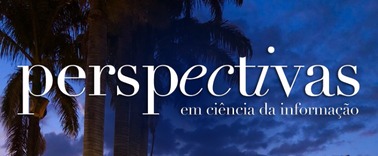|
|
Perspectivas em Ciência da Informação is a continuous flow publication of the Escola de Ciência da Informação (ECI) of the Universidade Federal de Minas Gerais (UFMG). It was launched in 1996, replacing the Revista da Escola de Biblioteca da UFMG, published from 1972 to 1995. It disseminates scientific articles in Information Science and its interdisciplinary dialogues with Librarianship, Archival Science, Museology and related areas, with the following prerequisites :
I. They must be unpublished, that have not been published and/or sent for evaluation in other journals or annals of events.
II. They must be written in one of these languages: Portuguese, English, Spanish.
-
Collaborating with the principles of academic multilingualism, all articles must contain the title, abstract and keywords, also in English.
III. Composition of authorship, regardless of professional affiliation and place of origin:
-
a) In the case of individual authorship, the author must have, exclusively, the title of Doctor.
-
b) In case of co-authorship, only one (1) of the authors may be in the condition of master or doctoral student, the others being obligatorily doctors.
-
c) In the case of multiple authorship (above three authors) the contribution of each author to the article must be presented.
-
d) Articles by graduates are not accepted in the journal.
IV. They must contain research results in the area of Information Science, explicitly highlighting objectives, procedures and analyses, and must not be a mere report of experiences or a bibliographic review.
V. They must follow the formal aspects indicated in the Guidelines for Authors.
-
At the time of submission, they should not be identified with the names of the authors in the original text. The authors of the manuscript must indicate their full names in the field established in the submission system, and it is also mandatory to inform the level of education, the ORCID number, institutional affiliation, the curriculum link (lattes for Brazilian authors) and the summary of the biography.
VI. This Journal is committed to ethics and quality in publishing. The Editorial Code of Conduct maintains Standards of ethical behavior expected of all parties involved in publishing in our journal: the author, the journal editor, the reviewers and the editor
VII. Opinions and perspectives expressed in the text, as well as the accuracy and origin of quotations, are the sole responsibility of the author(s), and contribute to the promotion of:
-
Princípios FAIR (findable, accessible, interoperable, and reusable – localizável,
accessible, interoperable and reusable).
-
DEIA principles (diversity, equity, inclusion and accessibility).
VIII. This Journal is commited to ethics and quality in publishing. The Editorial Code of Conduct supports standars of ethical behavior expected of all parties involved in publishing in our journal: the author, the journal editor, the reviewers and the ditor.
IX. All articles received will be submitted to the software Checkforplagiarism, to evaluate similarities.
-
Proposals submitted simultaneously to another national or international journal will not be accepted.
Manuscripts that are outside the editorial requirements of the Journal will be returned to the authors. In this set, there are texts that do not deal with a central issue in the field of Information Science and its interdisciplinary dialogues, mainly with Librarianship, Archival Science and Museology, and do not present significant contributions to the analysis of the theme addressed. Manuscripts will also be rejected that: are merely descriptive, without developing a theoretical and methodological analysis of the issue addressed; whether experience reports or fragments of dissertations and theses; do not present empirical elements or sufficiently developed arguments that support their analyzes and conclusions.
The Editorial Board may decide to publish an article, document, review, interview or special editions by order, with the purpose of collaborating with some more pressing debate in the area. This article or document will only be evaluated by the Editorial Board
Evaluation Policy
Submissions are evaluated based on the criteria listed below:
-
Adequacy to the scope of the Journal.
-
Compliance with guidelines for authors.
-
Formal structure of the work.
-
Correction, clarity and coherence of language.
-
Adequacy and quality of tables, graphs and illustrations.
-
Conceptual structure of the work.
-
Scope and relevance of the content in relation to the area.
-
Clarity and articulation of concepts and ideals.
-
Updating concepts.
-
Originality.
-
Other aspects that the reviewers deem relevant.
|
|


